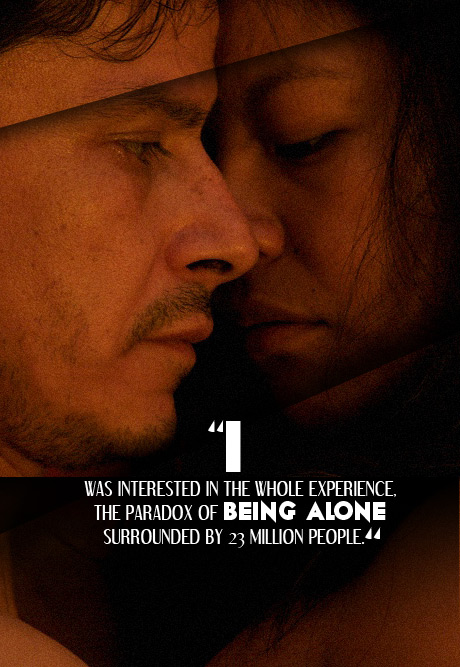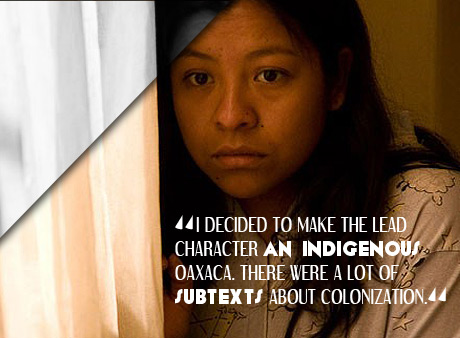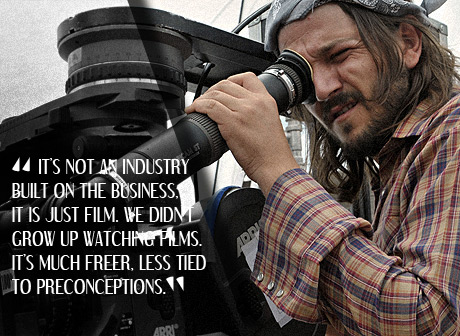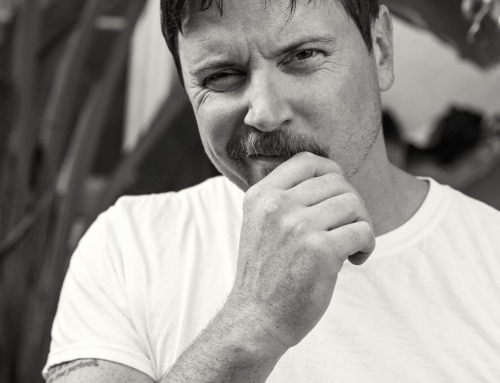The pajama jumpsuit with the little sheep on it is hers. She wore them around a one-bedroom apartment she lived in for days before shooting. And there’s more, much more, things right down to the Virgin Mary statue are taken from the actress’ actual home.
For his first feature, Leap Year, director Michael Rowe wanted everything to feel authentic. He wanted the actress to feel at home — when dealing with suicide, masturbation, rape, and torture, feeling comfortable in one’s surroundings is critical to achieving the raw visceral emotion Rowe was after. There could be nothing holding back her dexterity. And, while internally focused, the director sought to ensure this gutting tale of ego and abuse had an outward aesthetic that was truly Mexican, despite working within the narrow scope of the single apartment setting.

Leap Year (2010)
Sitting down with Rowe at the May Fair Hotel in London during the BFI London Film Festival, it was evident that he felt the tinge of being in a foreign land. Sheepish and soft-spoken, Rowe makes it clear he considers himself a citizen of the Latin American country since emigrating from Australia years ago.
“I arrived in Mexico without speaking Spanish, without really knowing anybody, no family,” explain Rowe. “And so I was interested in the whole experience, the paradox of being alone surrounded by 23 million people. But I’ve also been there for 16 years, so I’m not interested in doing a story about another gringo in Mexico.”
What Rowe wanted to bring to international audiences is the unseen character of Mexico. And for that, he looked to Leap Year’s lead actress, Monica del Carmen, a native of Oaxaca, whose faithful performance helped earn the film the Camera d’Or award at Cannes earlier this year. Interested in casting an indigenous woman, Rowe wanted his dark lead to represent a part of Mexico not normally seen. “There is a question of aesthetics and racism,” explains Rowe of what is typically found in the Mexican film industry. “The more European you look, the more beautiful you are considered to be. And as such, most actresses are European looking.”
The “racism” Rowe points to remains an essential part of society, directly tied to the socio-economic breakdown. In other words, class is in strict alignment with racial background. “This was something I wanted to explore in the film,” he notes. “I decided to make the lead character an indigenous Oaxaca. There were a lot of subtexts about colonization.”

Leap Year (2010)
Socio-political history is a subject that permeates the director’s work, as much as it does his thoughts. When Rowe arrived in Mexico, the landscape of the local film industry was starkly different to what it is today. The industry Rowe first found himself in best fits the description made by legendary and highly influential native director Alfonso Cuarón, who once likened it to a claustrophobic bubble. Concentrated and limited though it was, out of this primitive scene came a unique romance — a glimpse behind the veil haphazardly hung between the U.S. and Mexico, unearthing everything from border issues to drug wars to gangs to cultural and language barriers. Some have compared this powerful growth of cinema and auteur to France’s Nouvelle Vague cinema of the 1960s. As France did then, Mexico can now boast a self-sustaining and credible film scene outside of the hills of Hollywood.
And then there are those in the industry, like actor-turned-director Diego Luna, who have mastered balancing a career split between Hollywood and home. Getting his start in cinema acting alongside Gael García Bernal in Cuarón’s Y tu Mamá También, Luna has gone on to collect American screen credits including a role in Gus Van Sant’s Oscar-winning Milk, before moving on to his most recent role as director. Titled Abel, Luna’s feature directorial debut is produced by Canana Films, a Mexico-based production company set up by he and Bernal in 2005. The film has spent the last year traveling the international film festival circuit, London —where I catch up with Luna — being amongst its many stops.
After a bit of backing into a corner, the director rhapsodized on what is Mexican cinema, although, as he shares, to him it is simply what is familiar and natural.

Diego Luna behind the scenes on Abel (2010)
“They don’t make films to be popular, that’s the angle, it’s not a business in Mexico today,” explains Luna, noting the industry relies on small budgets and government funding through the Mexican Film Institute (IMCINE). “We finance films through funds and though tax breaks, it’s not our money. It’s not an industry built on the business, it is just film. We didn’t grow up watching films. It’s much freer, less tied to preconceptions.”
After discussing the light-hearted elements of making his first feature — specifically the fun he had — Luna indicates the importance of having the right representation.
“I wanted to be very specific about the context of the film, that’s why I wanted to look for the kid [the lead in Abel] in Aguascalientes,” he explains of the process. “Also, the crew was from Mexico, although some well known. The set designer, she’s very good, I mean she’s won an Oscar. But we all work together within Mexico.”
Revolución, another film Luna is currently promoting, has also been receiving attention from international critics. Made in honour of the centennial anniversary of the Mexican Revolution, the film is a collection of short films by current Mexican directors, each one a glimpse into the fragmented reality of modern day Mexico.
Despite heralding international acclaim, Mexican cinema’s toughest critics are the citizens of the country. But that is not to say the native audiences can’t spot a good film when it’s put in front of them, as Rowe himself learned when premiering his film in Mexico, just shortly before screening at the BFI London Film Festival. “I thought it wasn’t an easy sell for a Mexican audience very used to Hollywood and not very used to confronting movies.” He speaks of the nerves he felt premiering the film in a small conservative city in Mexico. “I was shitting myself, but it was brilliant. Standing ovations and people raving about it for days,” he gushes. “Right now it’s one of the top grossing movies that Mexican distributor has ever had.”
Global audiences and international critics take note, Mexican cinema is not the next big wave, it is the wave.











